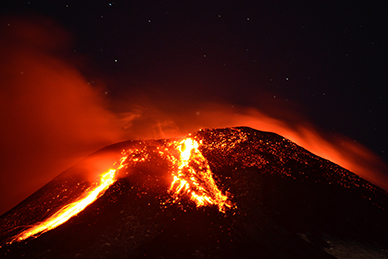- Alonso Arellano, an expert in geophysics and geology, explains that, due to the type of lava, the potential following events should not be catastrophic. “We may expect stronger eruptions to last for weeks or months.”
- He says that most of the gas column will pass to the Argentinean territory, just like on other occasions.
- “The alert actions taken for warning people have been adequate,” he says. He suggests people to be alert, because “there is always the possibility of fissures in the volcanic cone and lava could flow in other directions.”
After the Villarrica volcano’s eruption early in the morning on March 03rd, an area of 10 kilometre radius around the mountain was restricted. The area includes the Pucón, Villarrica and Panguipulli communities, where the red alert prevailed until yesterday evening. In the areas outside this radius, the Onemi national emergency office issued yellow alert.
Alonso Arellano, professor at the Department of Metallurgical Engineering and an expert in geophysics and geology, considers the actions taken as adequate. Dr Arellano has worked on the study and analysis of predictive models for volcanoes.
“The actions taken are in the scope of what is expected in alert situations and they should not lead to complications,” he says.
He says that the places over which lava flows have been studied and identified, “however, there is always the possibility of fissures in the volcanic cone and lava could flow in other directions,” so he asks people to be alert.
“We have to live with volcanoes and some of their properties are unpredictable. We cannot say that everything is under control, but the alert actions have been suitable, because the country has enough experience,” he explains.
Known behaviour
The expert explains that the basaltic magma typical of the Villarrica volcano is made up of dark- to- intermediate-coloured minerals like pyroxene, olivine, some iron and amphiboles, which are rocks with higher melting points. This means that gases can flow more easily in comparison with other thicker or less liquid types of magma, avoiding gas accumulation and pressure build-up inside the volcanic cone.
“Due to the type of lava, the volcano’s behaviour should be similar to the one in previous eruptions, with a constantly increasing and decreasing activity. If the magma flows over the volcano slopes, it will depend on its pressure and on how it goes up the vent,” he said.
Professor Arellano says that these events could continue. “We may expect stronger eruptions for weeks or months.”
With regards to the risks to people, professor Arellano explains that besides the risk posed by lava itself, ashes could be harmful. However, he says that most of the gas column will pass to the Argentinean territory, just like on other occasions.
Professor Arellano holds a PhD in Engineering Sciences with a major in geophysics, geology and geothermal science.
Translated by Marcela Contreras



